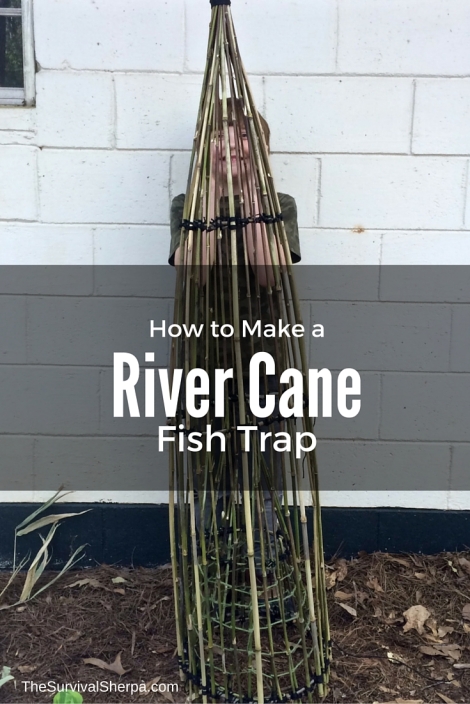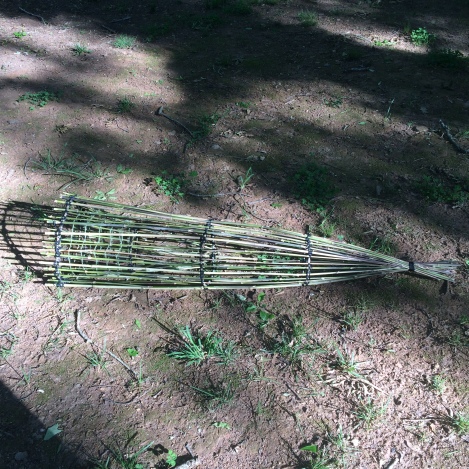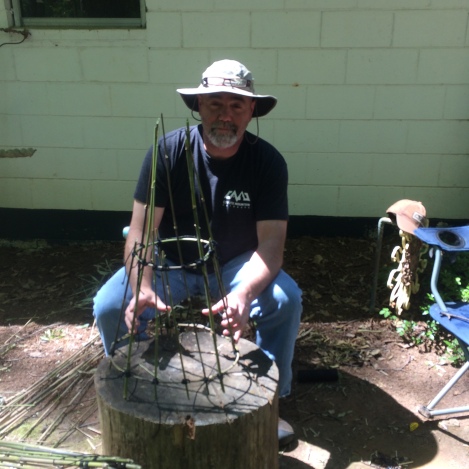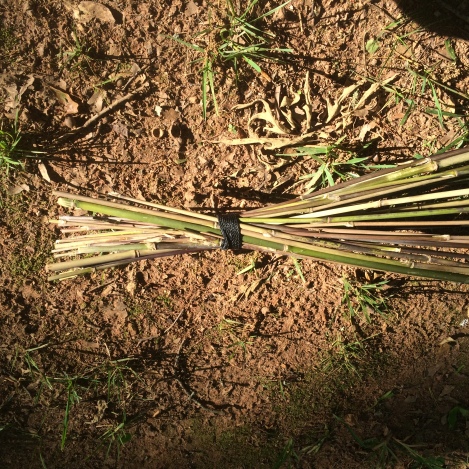by Todd Walker
Give a man a fish and he eats for a day… teach him to make a fish trap and he feeds himself and his tribe!
On the heels of our last post on river cane, I thought you may be interested in how to build a traditional fish trap. The beauty of any kind of trapping device is its ability to passively gather protein while you spend valuable time doing other stuff. Set it and forget it.
This funnel trap is not a “survival” trap. Your time would be better spent in a short-term survival scenario than burning calories collecting resources and lashing cane. However, for a long-term, consistent fish-catcher, take your time and build it to last.
Admiration and many thumbs-up signs go out to all aboriginal people who built one of these from scratch. The sheer amount of cordage needed is daunting enough using modern bank line. If my only lashing option was natural cordage, I’d choose to make a woven basket to eliminate the cordage requirement. Raw hide may have been used by our ancestors. I had enough bank line, so I used it.
Building a River Cane Fish Trap
Before you get your taste buds riled up, check your local game laws regarding fish traps. In my state of Georgia, you must have a commercial fishing license and traps have to be built to meet certain standards with respect to materials, size, and use. This trap fails the state standard. Chicken wire is required and does not grow naturally in the eastern woodlands. River cane does and was used to construct this self-reliance experiment for educational purposes only.
Our video tutorial is up for those who like this format:
Material and Tools
- River cane of various lengths and diameter (thumb-size to pencil-size and at least 6 feet long). Non-native bamboo is a good substitute.
- Cordage ~ Bank line, jute twine, or raw hide and natural cordage for the purists.
- Knife or pruning shears
You’ll need lots of time, patience, and knots once you gather the river cane.
Build 3 Hoops
Either use freshly cut cane or other flexible branches. In my experience, cane cut over a week ago won’t bend for the hoops without heating. All I had was older cut cane at my shelter when I began this project. I improvised and tested two pencil-size species: Tulip Poplar and American Beech. Tulip poplar worked for the largest hoop (15 inch diameter) but was too brittle for the medium (12 inches) and smallest (8 inches). All three of the hoops on the larger funnel are beech limbs.
Cut lengths for your desired diameter. Overlap the ends and lash together. I started the lashing with a bowline knot and terminated the lashing with a clove hitch. Apply gentle pressure to the hoops to create round supports for the river cane ribs to be attached.
Harvest and Prepare Cane Ribs
Harvesting river cane has inherent risks. Snakes, chiggers, and ticks make canebrakes home. Prepare accordingly.
River cane has two leaf types: Clum leaf and branch leaves. Clum leaves form a protective sheath which hug the clum upward from each node. The branch leaves grow from the end of the new branches coming off nodes.
To remove the clum leaves, grip and twist the sheath-like leaf at each node. It’s not necessary to remove these leaves if you’re pressed for time. Then again, if you’re pressed for time, this project may not be for you. The branches protruding from the upper nodes are easily removed by pulling them down towards the base of the clum.
Trim and blunt the ends of the cane to avoid accidental puncture or cuts while building and using your trap.
Attach Cane Ribs
Use four of your more robust canes to start framing your trap. It’s not that important which knots/lashings you use. They just need to hold the ribs securely to the hoops. I used square lashing with bank line on most of the ribs initially. However, as more cane is added to the frame, space becomes limited. Get creative with knots.
Attach the larger ends of the tapered cane to the largest hoop at 12:00, 3:00, 6:00, and 9:00 with about a couple of inches overlapping past the hoop. Repeat the process about halfway down the four canes with the medium hoop. I found that laying the frame on the ground to attach the remaining hoops speeds up the process.
Lash the smallest hoop about 18 inches from the middle hoop. With the three hoops attached to the four canes, you have a steady framework on which to add the remaining ribs. Don’t worry about cutting all the ribs to the same length at the onset. They can run wild and be trimmed even at the end of the project.
Add more cane ribs… Add more cane… Add more… you get the picture. This labor of love eats up most of you time. As the spacing between ribs narrowed, I began tying a modified diagonal lashing. On tight spaces, I simply wrapped the cordage around the cane and hoop and tied a square knot.
The spacing between canes at the opening of the trap are naturally wider than those at the tip end. After testing, I may have to weave cordage between the ribs to add rigidity to the funnel and lessen the chance of smaller fish escaping. I’ll update you after the field test.
Build the Inner Funnel
On this day, I had freshly cut river cane. I used it to make two hoops. I can say that it is better and more flexible than the beech used in the larger funnel.
The interior funnel hoop is slightly smaller in diameter than the opening of the large funnel. The small hoop of the interior funnel was about 7 inches in diameter.
Build the frame of this funnel in the same manner as the larger one. Use smaller diameter cane with the large ends attached at the larger hoop (opening end). Allow the smaller, more flexible ends to run past the smaller inside hoop by 6 to 7 inches.
In theory, doing so will allow fish to swim through the flexible funnel end but prevent them from leaving. Kinda like a line from the Eagles hit song, Hotel California… “you can check in anytime you like, but you can never leave.”
Connect the Two Funnels
Once the interior funnel is complete, insert it into the larger funnel opening. Lash the two hoops together so that the inside funnel is somewhat straight and even with the large funnel. Secure the hoops at several points around their circumference in a permanent fashion.
You’re almost done!
Close the Trap Tip
Gather the cane at the tip of the trap at a point with about 6 inches of cane remaining. Lash this point with a knot that is secure but can be easily untied. This is the end you will untie and empty your trap of all the fish you’ve caught… fingers crossed.
Once the tip end is lashed, trim the wild ends. One whack from a machete on a chopping block and your done.
One last detail you’ll need to take care of if you use nylon bank line. Cut and melt the ends of all those tag ends of cordage. If you have a soldering torch (not very primitive, I know), simply burn the tag ends so they don’t unravel. Take care not to melt the lashings or set the cane on fire. Melted nylon is no joke on your skin. Be careful.
Bait the Trap
Wrap your bait of choice in panty hose or cheese cloth and suspend it from the inside of the trap. Catfish like stinky stuff like chicken liver, dead fish, and commercial blood bait.
Attach a sturdy line(s) to a larger rib/hoop junction for lowering and raising the trap. You’ll also want to attach an anchor to sink the trap as river cane floats. Use a jug at the end of the line to mark your trap in deep water. Near the bank you can tie the line to a tree or limb. My experience with chicken wire traps in my childhood was that I caught more turtles than catfish in shallow waters.
Leave the trap submerged for several hours or overnight. Check the trap regularly and follow local game and fishing laws.
An update will be coming on the functionality of the trap. Max and I didn’t have time to get it in the pond. If it’s anything like the chicken wire traps we used years ago, we won’t go hungry if we ever have to depend on this river cane trap.
Keep Doing the Stuff of Self-Reliance,
Todd
P.S. – You can also keep up with the Stuff we’re Doing on Twitter, Pinterest, Google +, YouTube, Instagram, and Facebook… and over at the Doing the Stuff Network.
P.P.S – If you find value in our blog, Dirt Road Girl and I would appreciate your vote on Top Prepper Sites! You can vote daily by clicking here or on the image below. Check out all the other value-adding sites while you’re there… 
Thanks for Sharing the Stuff!
Copyright: Content on this site (unless the work of a third-party) may be shared freely in digital form, in part or whole, for non-commercial use with a link back to this site crediting the author. All links in articles must remain intact as originally posted in order to be republished. If you are interested a third-party article, please contact the author directly for republishing information.














Todd, that is a very impressive bit of cordsmanship!!
Nice job!
All the best-
Jim M.
LikeLike
I don’t want to tie anymore knots for a while 🙂 Thank you, Jim!
LikeLike
So maybe not the most environmentally friendly solution, but if you have an old plastic water cooler jug you can accomplish a pretty similar thing in about 5 minutes with a knife and some string. Cut the top off the jug, flip it over, poke holes as needed, lace it on with string, weight with whatever, mark location, and deploy. We used to make 2 liter soda versions to catch crayfish for bait. It wasn’t an issue with the soda bottle size, but with the water cooler size you might want to poke some small holes in the bottom to drain the water when you haul it in.
LikeLike
The big plastic bottle may work. Have you tried that one out?
I wanted to do this style trap with resources available in my woods. It did take quite a bit of time but knowing that I can and could build them in the future is beneficial.
Thanks for the idea, M!
LikeLike
Pingback: Prepper News Watch for April 25, 2016 | The Preparedness Podcast
Great tutorial ! I saw also the progress in your instagram page , a piece of primitive art!
LikeLike
Many thanks, Mattia! Hopefully, it will be functional art 🙂
LikeLiked by 1 person
Pingback: Hunt-Gather-Eat: Identifying Plants the Real Food Eats | Survival Sherpa
Pingback: How to Bushcraft a Hollow Log Crawfish Trap | Survival Sherpa
Pingback: How to Bushcraft a Hollow Log Crawfish Trap | Prepper's Survival Homestead
Pingback: all prep site
Pingback: all prep site
Pingback: Wild Resources: Only a Fool Comes Home Empty Handed! | Survival Sherpa
You build very, very strongly!
LikeLike
Thanks, James!
LikeLike
Pingback: 9 Ways (Some Illegal) to Catch Fish for Self-Reliance and Survival | Survival Sherpa
This is exactly what people need to know how to do if they ever stuck lost in nature without most important things to survive… You must know how to do fish trap because maybe one day that will save your life…
LikeLike
I realize this is an older post but there is a way to tie less knots….
Create your hoops like normal then weave your ribs through the hoops. tie your end to the biggest hoop and tie the bottom closed. also for the inner funnel just create a small hoop and tie ribs to this hoop.when you insert this into the main funnel you then tie the ribs to the largest hoop at the opening.
Now we do this with Willow branches which are super flexible so It may be easier on the weaving.
I have read a lot of this blog over the last few weeks and really enjoy it.
LikeLike